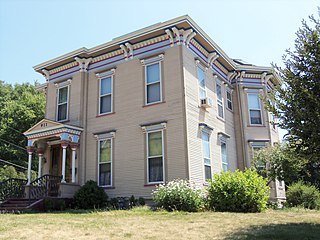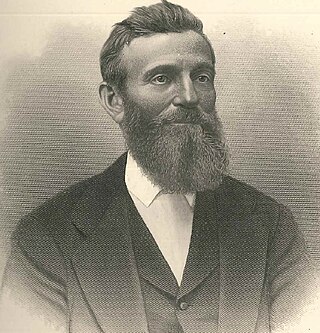This article includes a list of references, related reading, or external links, but its sources remain unclear because it lacks inline citations .(March 2013) |
Chancy Lamb was a pioneer in the lumber industry in Clinton, Iowa.
This article includes a list of references, related reading, or external links, but its sources remain unclear because it lacks inline citations .(March 2013) |
Chancy Lamb was a pioneer in the lumber industry in Clinton, Iowa.
Chancy Lamb was born in Ticonderoga, New York, January 4, 1816. He was the son of Alpheus and Mrs. Sophia (Bailey – Wilkerson) Lamb. His father was a descendant of Thomas Lamb, who came from England with Governor Winthrop’s fleet in 1630, and settled at Roxbury, Massachusetts. Chancy Lamb spent his early life on a farm, enjoying an occasional winter of schooling in the common schools of the neighborhood. In 1836 he went to Benton, New York, where he engaged in the manufacture of wagons, and, as well, learned the trade of millwright. Two years later, in 1838, he moved to Bradford, New York, where he went to work in a saw mill, and for the next three years was thus engaged, the larger portion of the time sawing by the thousand. In the summer of 1841 he commenced the construction of a saw mill on the outlet of Lake Keuka, near Penn Yan, New York for R.L. Chapman of Steuben County, New York completing it in the spring of 1842, during which season he operated the mill under contract with the owner. In November of that year he returned with his family to Bradford, where he took a contract to run the saw mill of Cameron, Thurman & Co., and continued in the capacity of superintendent with this firm until the summer of 1844, when he moved with his family to Carroll county, Illinois, where he spent several years in farming.
In 1851 he moved to Williamsport, Pennsylvania, and accepted the position of superintendent in the mill operations of his former employer, J.C. Cameron & Co., and in the following year operated the mills of this company in Chemung County, New York, sawing by the thousand and continuing in this business for the next five years.
In November, 1856, Lamb again moved west, and for a few months was a resident of Fulton, Illinois, but in 1857 he took possession of the saw mill at Clinton, which he purchased from Gray & Lunt, and which he had helped to build. This mill burned October 6, 1857, and Lamb at once erected a much better mill, which he operated until November 14, 1876, when it, too, was destroyed by fire. In March, 1868, he laid the foundations of a stone structure saw mill, which went into commission in September of the same year, which, with the rebuilt mill which replaced the one which was burned, and the subsequent acquisition of the Cobb mill and Wheeler & Warner mill, produced about 100,000,000 board feet (200,000 m3) of lumber and 50,000,000 shingles a year.
Lamb was one of the most progressive men in the trade, and it is claimed that he was the first man to use the band saw in the manufacture of white pine lumber, his practical experience readily discerning the value of so economical a device, which, in its experimental stages, others were hesitant about testing. He was also among the first to employ steam-boats in the towing of log rafts upon the Mississippi for the more expeditious, as well as more economical method over the prevailing custom of floating with the current. He from time to time built what may be termed a full fleet of steam-boats expressly for the towing business.
In 1864 his son, Artemus Lamb, and in 1873 another son, Lafayette Lamb, were taken into partnership with their father, and in January, 1878, articles of incorporation were taken out under the name of C. Lamb & Sons.
Mr. Lamb was from the first, president of C. Lamb & Sons, incorporated; was also president of the Clinton Savings Bank, and a director in various companies, including the Mississippi River Logging Company; the Mississippi River Lumber Company; the Shell Lake Lumber Company; the People’s Trust & Savings Bank of Clinton; the Clinton National Bank (http://www.clintonnational.com/), and of the Clinton Gas Light & Coke Co. and Clinton Water Works Co.
He was an ardent Republican in politics, but never sought nor held office, never seeking to unduly influence the opinions of his employees upon political matters recognizing the duty of all men to exercise an intelligent and unbiased franchise according to individual and conscientious judgement. While never a member of any religious body, his life was moulded upon the highest plane and with decided opinions upon religious subjects, he was a liberal giver to all worthy church and other work calculated to raise the standard of morality, and ameliorate the condition of his fellow men.
Lamb was married November 16, 1839, to Miss Jane Bevier of Bradford, New York, whose father David Bevier served as adjutant of the Third Ulster County, New York, regiment in the revolutionary war. The Lambs were married for fifty-eight years, during which time two sons, Artemus and Lafayette, and four daughters, Augusta, Celesta, Merrette and Emma E., were born to them. Celesta and Merrette died as children. Mrs. Lamb died on March 5, 1897. Mr. Lamb died four months later, on July 12, 1897.

Clinton is a city in and the county seat of Clinton County, Iowa, United States. The population was 24,469 as of 2020. Clinton, along with DeWitt, was named in honor of the sixth governor of New York, DeWitt Clinton. Clinton is the principal city of the Clinton Micropolitan Statistical Area, which is coterminous with Clinton County. Clinton was incorporated on January 26, 1857.

Laurel is a city in and the second county seat of Jones County, Mississippi, United States. As of the 2020 census, the city had a population of 17,161. Laurel is northeast of Ellisville, the first county seat, which contains the first county courthouse. It has the second county courthouse, as Jones County has two judicial districts. Laurel is the headquarters of the Jones County Sheriff's Department, which administers in the county. Laurel is the principal city of a micropolitan statistical area named for it. Major employers include Howard Industries, Sanderson Farms, Masonite International, Family Health Center, Howse Implement, Thermo-Kool, and South Central Regional Medical Center. Laurel is home to the Lauren Rogers Museum of Art, Mississippi's oldest art museum, established by the family of Lauren Eastman Rogers.
PotlatchDeltic Corporation is an American diversified forest products company based in Spokane, Washington.

The Chippewa River in Wisconsin flows approximately 183 miles (294 km) through west-central and northwestern Wisconsin. It was once navigable for approximately 50 miles (80 km) of its length, from the Mississippi River, by Durand, northeast to Eau Claire. Its catchment defines a portion of the northern boundary of the Driftless Area. The river is easily accessible for bikers and pleasure seekers via the Chippewa River State Trail, which follows the river from Eau Claire to Durand.

Artemus Lamb Gates was an American businessman, naval aviator, and Assistant Secretary of the Navy for Air in charge of naval aviation efforts in World War II. He also was briefly Undersecretary of the Navy. He was, at various times, president of New York Trust Company, and a director of Union Pacific, Time, Boeing, Middle South Utilities, Safeway Inc., Abercrombie & Fitch Co., and Servo Corp.

William John Young was the founder of the W.J. Young Company. He revolutionized the slow system of rafting logs by floatage with the current of the river in 1865 by a successful experiment of pushing log rafts ahead of a steam boat, independent of the river currents, and this with his introduction of the system of brail rafting, facilitated the movement of log stock while greatly lessening the expense of delivering them from the booms at Reef Slough and other points, to the mills at various points on the lower river; but for these advantages, the work of the mills would never have reached the vast volume to which they soon attained. Mr. Young was one of the original members of the Mississippi River Logging Company, his interest in which he sold in 1893, after being for many years one of the most active and influential members of the company.
Curtis Bros. & Co. was a leading producer of doors, sashes, blinds and general house finishings between 1866 and 1966. The company was the first to produce pre-glazed window units.

David Joyce was an American "lumber baron" and industrialist. His fortune was eventually inherited by Beatrice Joyce Kean who used it to establish the Joyce Foundation in 1948.

The Loyal Legion of Loggers and Lumbermen (Lllw), commonly known as the "Four L" (4L), was a company union found in the United States during World War I in 1917 by the War Department as a counter to the Industrial Workers of the World.

George Martin Curtis was a two-term Republican U.S. Representative from Iowa's 2nd congressional district.

The Pennsylvania Lumber Museum is near Galeton, Potter County, Pennsylvania in the United States. It documents the history and technology of the lumber industry that was a vital part of the economic development and ecological destruction of Pennsylvania.
Benjamin Hershey was a lumber and farming magnate in the U.S. states of Iowa and Nebraska during the middle to late 19th century.
The Finkbine-Guild Lumber Company was established to harvest and market the virgin longleaf pine stands of southern Mississippi during the early 20th century. The main sawmills were located in Wiggins and D'Lo, Mississippi. When the local timber supply dwindled, the company tried to utilize redwood trees from California, but that operation failed because of high transportation costs. Other attempts were made at promoting a more diversified use of the cutover timberlands; some ventures were successful while others were not.

The James E. Lindsay House is a historic building located on the east side of Davenport, Iowa, United States. It has been listed on the National Register of Historic Places since 1984.

The Mueller Lumber Company was located in downtown Davenport, Iowa, United States. The property was listed on the National Register of Historic Places in 1983. It has since been torn down and it was delisted from the NRHP in 2005. The site is now the main clinic for Community Health Care.
Musser Lumber Company was a US lumber company, and one of Iowa's pioneer lumber concerns. In its day, it was one of the most complete and modern lumber mills on the Mississippi River, employing about 400 men during the working season, and between 200 and 300 men in the logging end of the business.
Arfst Frederich Frudden (1854-1931) was a German-American politician and businessman from Föhr. Emigrating to Iowa in the 1870s, he co-founded a lumber company in 1888. He advocated for lumbermen in several trade organizations, then was nominated by the Democrats to serve in the Iowa House of Representatives and later the Iowa Senate.

Delos L. Filer was a businessman involved in developing Manistee County and the towns of Manistee, Filer City and Ludington in the state of Michigan. He owned sawmills and related businesses.
The Pas Lumber Company was a forestry company that owned and operated several sawmills and logging operations in Manitoba, Saskatchewan, and British Columbia.

Truman I. Lacey (1834–1914) was an American architect in practice in Binghamton, New York from 1872 until 1914.